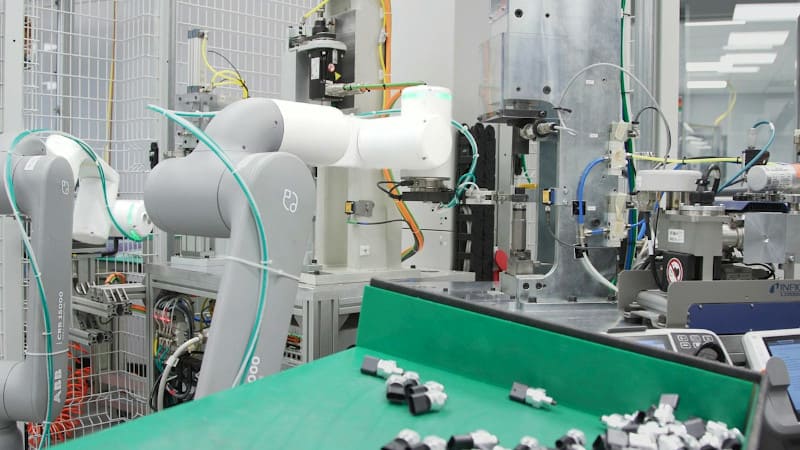An Italian SME manufacturer of pressure and temperature sensors has used ABB GoFa robots to improve the productivity of one of its production lines, increase quality and reduce scrap to near zero.
Brimind is a manufacturer of pressure and temperature sensors for industrial and automotive use. Operating as a Tier 1 supplier to the automotive industry, the company is certified to the IATF 16949 automotive quality standard. The standard helps organizations maintain consistency in the quality of products and services, reduce variation and waste and prevent defects.
To meet the high quality expectations of its automotive customers, Brimind was keen to automate some of the subprocesses in one of its production lines.
The line produces a combined pressure and temperature sensor for vehicle air conditioning systems. Brimind identified two machine tending tasks that a robot could perform on the line.
The first task involves taking the electronic core of the sensor and mating this into the aluminium body. The second task is to take the assembled sensor body and move it to a leak testing station.
Ideal for cobots
Brimind had previous experience of using robots in assembly tasks and chose ABB’s GoFa collaborative robot for this application. The production line for this product was ideal for the introduction of collaborative robots. “This assembly line is modular with the stations separated one-by-one into subprocesses,” says Leo. “By introducing automation using collaborative robots, we maintained this modularity because there is no need for the huge protective barriers to separate the existing stations or disturb the link between those three stations and the rest of the line.”
With the sensor having small dimensions and weight, it was also an ideal product to test the application of cobots to the company’s manufacturing process.

Two ABB GoFas were installed in December 2021. They operate at three stations. The first robot at the first station assembles the two components, the electronics and the body, and moves them to the second station. Here, the second GoFa closes up the assembly to secure it and then passes the completed product to the testing station, where it is tested for leaks.
Better than expected productivity
The cobots have already exceeded expectations for productivity. The initial manual method achieved an OEE of close to 90 percent. Brimind had a goal of increasing this to around 95 percent – the actual results show that the assembly stations are now achieving productivity of 97 percent.
Daniele Bini, process engineer at Brimind says: “The GoFa cobots bring a lot of flexibility and repeatability to the process line – they can be used to handle a wide variety of pieces and offer the ability to produce a small sample of products with the same quality as large-scale mass production.”
The GoFa cobots are also easy to program. Says Bini: “With just a button I can move the robot to a new position or change its configuration just with my hand rather than by moving it with the controller. This means that we can limit the stoppage time when we need to reprogram the robot.
To help create a reconfigurable production line and reduce the time for installing future lines, Brimind set up the cobots itself, with close support from ABB. “They were very quick to send the information I needed, for example, some electrical schematics or some information about the movements or instruction of the programmer,” adds Bini.
The role of the operator has changed from being a machine manager to that of line manager, overseeing the machines rather than feeding them components. Because fewer people are needed, they can be used in other roles.
Looking to the future, Brimind is keen to apply robots to other parts of its production. “We can apply automation to several other stations in the same production line and to two additional production lines we have for sensors and valves,” adds Leo.

